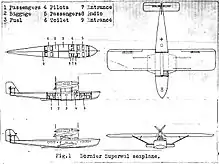Dornier Do R
The Dornier Do R Superwal was a German flying boat airliner of the 1920s.
| Do R Superwal | |
|---|---|
 | |
| Role | Flying Boat Airliner |
| Manufacturer | Dornier |
| First flight | September 1926 |
| Primary users | Deutsche Luft Hansa SANA |
| Number built | 19 |
Development
The Do R was a larger development of the Do J, with a larger high-mounted strut-braced monoplane wing and longer fuselage. All but the first three built also had four engines, in place of the Do J's two. The Do R could carry 19 passengers in two cabins; 11 in the forward cabin and eight in the rear.
Dornier R 2 Superwal
The first R 2 Superwal, (D-1115), made its maiden flight on 30 September 1926. Two 650 hp Rolls-Royce Condor III engines were mounted in tandem in a nacelle above the wing and in line with the hull; one engine drove a tractor propeller and the other drove a pusher propeller. D-1115 was the largest flying boat that could be built in the postwar Dornier factory in Manzell. The Superwal went into service with Severa and later DVS in List, both organisations of the German government, tasked to develop military seaplanes, ignoring restrictions of the Versailles treaty. Two more R 2 Superwals were built in 1927 for Severa (D-1255 and D-1385). D-1255 was periodically operated by Deutsche Luft Hansa and was named Narwal. D-1385 was equipped with 800 hp Packard engines, and remained in service until November 1936.
Dornier R 4 Superwal
Between 20 January and 5 February 1927 Dornier Chief Pilot Richard Wagner established twelve world records for seaplanes with a new R4 Gas Superwal. This aircraft and eleven more with Gnome et Rhône Bristol-Jupiter engines (R4 Gas) or 525 hp Siemens-Bristol-Jupiter engines (R4 Sas) were delivered to the Italian airline Società Anonima Navigazione Aerea (SANA) and Luft Hansa during 1928 and ‘29. Apart from their use by Luft Hansa, six Superwals saw regular service with SANA into the early 1930s on a route along the Italian west coast and on to Spain. Three aircraft were lost during their service. The Superwal I-RUDO (equipped with Isotta Fraschini Asso 500 engines) went into service with the Italian Air Ministry in 1934 and became the last Superwal in Italian service. At least one aircraft was assembled in Spain by CASA.
Variants
- R2 - early version with two Rolls-Royce Condor III inline engines (three built)
- R4 - definitive version with four engines in two tractor-pusher pairs
- R4 Gas - with Gnome et Rhône-built Bristol Jupiter radial engines (two built)
- R4 Nas - with Napier Lion inlines (two built)
- R4 Sas - with Siemens-built Bristol Jupiter radials (ten built)
- R4 Cas - with Pratt & Whitney Hornet radials (two built)
Specifications (R4Gas)

General characteristics
- Crew: four
- Capacity: 19 passengers
- Length: 24.60 m (80 ft 9 in)
- Wingspan: 28.60 m (93 ft 10 in)
- Height: 6.00 m (19 ft 8 in)
- Wing area: 137.0 m2 (1,474 sq ft)
- Empty weight: 9,850 kg (21,720 lb)
- Gross weight: 14,000 kg (30,900 lb)
- Powerplant: 4 × Siemens-built Bristol Jupiter VI , 360 kW (480 hp) each
Performance
- Maximum speed: 210 km/h (130 mph, 110 kn)
- Range: 1,500 km (930 mi, 810 nmi)
- Service ceiling: 1,500 m (4,900 ft)
References
- Taylor, Michael J. H. (1989). Jane's Encyclopedia of Aviation. London: Studio Editions. p. 328.
- World Aircraft Information Files. London: Bright Star Publishing. pp. File 892 Sheet 27.
- "Berlin Aero Show 1928". Flight: 908–09. 18 October 1928. Retrieved 2008-02-28.
- "The New Dornier Super-Wal". Flight: 18. 12 January 1928. Retrieved 2008-02-28.
- "The Dornier Super-Wal". Flight: 817. 9 December 1926. Retrieved 2008-02-28.
- "A New Dornier Super-Wal". Flight: 199. 22 March 1928. Retrieved 2008-02-28.
External links
- German aircraft between 1919 - 1945
- Planes Planned For TransAtlantic Service article on Dornier R 2 Superwal September 1927 Popular Mechanics